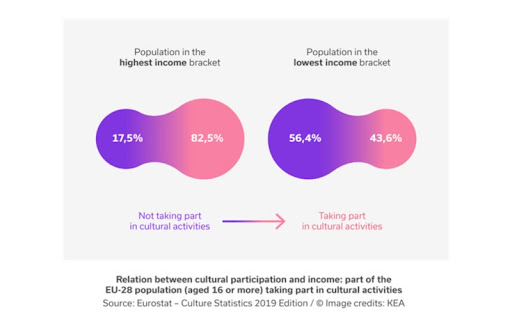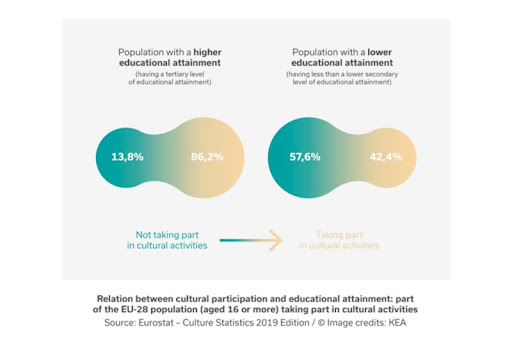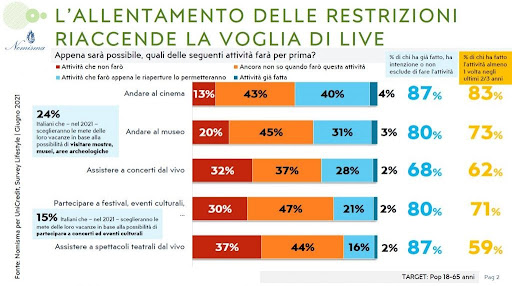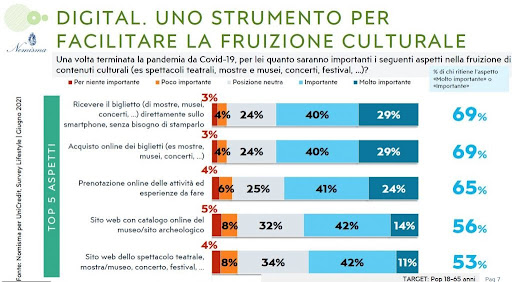Fourth wall and digital windows: dialoguing with new cultural audiences
07 December 2021
“Coinvolgere nuovamente il pubblico e rigenerare la partecipazione attiva, in un modo che sia lo stesso pubblico ad aiutare a sostenere e far crescere una nuova “offerta”, questa è la vera priorità”.
La pandemia ha posto l’attenzione sull’importanza economica del settore culturale, in particolare quella dei festival, degli eventi dal vivo, dei musei, dei cinema o della vendita al dettaglio di servizi culturali, nel rendere i luoghi attraenti per chi li vive tutto l’anno e per chi come i turisti li vive periodicamente.
Quello che certamente è mancato molto durante i periodi di chiusura imposti dalla pandemia sono state le esperienze culturali dal vivo, mancanza cui si è cercato di sopperire attraverso lo streaming digitale che però si è rivelato poco fecondo per le attività di public relations e gli incontri culturali collettivi.
I servizi culturali svolgono un ruolo fondamentale nella costruzione del benessere delle comunità e della coesione sociale: la cultura non è solo intrattenimento e svago ma contribuisce in maniera incisiva alla costituzione di senso collettivo grazie alla sua accessibilità.
Cosa si intende propriamente quando parliamo di accessibilità culturale?
Un museo, un teatro, un festival, per potersi definire accessibile deve essere prima di tutto un luogo empatico, piacevole, accogliente, capace di rimuovere le proprie barriere (non solo fisiche ma anche – e soprattutto -culturali ed economiche) non a crearne di nuove.
Questo concetto è fondamentale per poter osservare quanto, paradossalmente con l’imposizione di nuove barriere fisiche (spazio di distanziamento, controlli agli accessi) il momento storico del post pandemia, con la fiorente attività digitale del settore culturale registrata durante i due lockdown, rappresenti in realtà un’occasione per abbattere quelle che sono da sempre le barriere di accesso alle attività culturali.
A tal proposito, i dati delle statistiche di Eurostat mettono in chiaro quanta correlazione esiste tra partecipazione culturale e reddito, con l’82,5% della popolazione dell’UE-28 (di età pari o superiore a 16 anni) nella fascia di reddito più alta tra coloro che prendono parte ad attività culturali, rispetto al 43,6% nella fascia di reddito più bassa. Il secondo motivo più citato come causa per non aver partecipato alle attività culturali sono state le difficoltà finanziarie.
La partecipazione culturale è anche correlata al livello di istruzione: l’86,2% della popolazione con livello di istruzione terziaria dichiara di aver preso parte ad un’attività culturale negli ultimi 12 mesi, rispetto al 42,4% tra le persone con un livello di istruzione secondaria di primo grado o inferiore.


Oggi, con l’obiettivo di creare condizioni favorevoli per la soppressione definitiva di diseguaglianze, si rivela fondamentale – e possibile – dover includere la cultura nelle politiche sociali ed educative affinché gli operatori e le istituzioni culturali siano messi nella condizione di coinvolgere la comunità verso un dialogo interculturale: la generazione futura vive nel mondo virtuale, un mondo che rende tutto accessibile e che non richiede le interazioni tradizionali; l’accesso alla cultura è il regno dei motori di ricerca, dei server digitali e dei social media tanto quanto delle istituzioni culturali. La capacità di concentrazione è diversa. Richiede immagini e pedagogie veloci per apprendere o sperimentare rapidamente. Il COVID-19 sta accelerando una mutazione dello stile di vita che è familiare alle giovani generazioni. È più individualista, incentrato sulla vita privata, con comunità di più piccole dimensioni che fanno affidamento sulle reti digitali e virtuali.
Inutile negare che la cultura intesa come segno di conoscenza è sempre più considerata appannaggio di vecchio elitarismo che può essere disprezzato e persino denigrato. La nuova generazione urbana appartiene sempre meno a una data religione, a un territorio, a una cultura: la sua cultura è sempre più il pianeta: la lingua è cambiata, con una nuova funzione più visiva, più inglese, più urbana con nuovi strumenti per interagire socialmente attraverso le frontiere.
Tutto questa rappresenta una minaccia per le istituzioni culturali consolidate incapaci di adattarsi ai nuovi modelli sociologici. La pandemia influenzerà i comportamenti collettivi e le culture nella stessa misura in cui l’ha fatto l’invenzione della scrittura o della stampa all’epoca. Diventa quindi importante per le istituzioni culturali, riflettere e adattarsi a questi cambiamenti sociali e alle politiche culturali per continuare ad affermare il loro ruolo di costruttore del senso collettivo e contribuire all’empowerment sociale.
Che tipo di offerta culturale si aspettano quindi gli italiani a seguito del post pandemia?
La ricerca condotta da Nomisma nel mese di giugno 2021 focalizza i suoi dati sulle aspettative degli italiani in merito alla fruizione di contenuti audiovisivi e culturali (musica, teatro e cinema) nel post Covid.
Nel 2020 il numero di spettacoli teatrali, cinematografici e concertistici dal vivo hanno subito una diminuzione del 69% rispetto al 2019, mentre la spesa del pubblico si è ridotta del -78,8% in confronto all’anno precedente.
Questo non ha però frenato la fruizione di prodotti culturali da parte degli italiani che hanno sperimentato nuove modalità per assistere a spettacoli e concerti. In particolare, è stato rilevato che dall’inizio della pandemia il 33% ha seguito dirette social in cui musicisti e cantanti famosi si esibivano dalle proprie abitazioni, il 13% ha visitato virtualmente mostre, musei, aree archeologiche, il 6% ha visto spettacoli teatrali in streaming e il 4% ha assistito a concerti virtuali, direttamente dal proprio pc, pagando un biglietto.
Le mura domestiche sono diventate un vero e proprio luogo di intrattenimento: il 36% degli italiani ha infatti incrementato la fruizione di film e di serie tv a pagamento e il 61% ha visto più spesso (o ha iniziato a farlo) film e serie tv su piattaforme online. Il 55% delle persone, inoltre, ha dichiarato di aver dedicato più tempo alla visione di programmi e film in televisione rispetto al 2019.
L’allentamento delle restrizioni, d’altra parte, fa crescere negli italiani la voglia di assistere di nuovo agli eventi dal vivo: il 40% si dice pronto a tornare al cinema, 1 italiano su 3 a visitare un museo, il 30% è impaziente di assistere a un concerto live e 1 italiano su 6 ha intenzione di partecipare a uno spettacolo teatrale.

La survey Nomisma ha indagato quale sia l’offerta culturale ideale per gli italiani nel post-Covid e ha rilevato che il 36% desidera una proposta con una vasta quantità di contenuti e vicina ai propri gusti e interessi (fattore, quest’ultimo, citato dal 18% degli italiani).
Molto importante risulta la facilità di fruizione: il 24% mette al primo posto la possibilità di accedervi in ogni momento della giornata e il 14% da ogni luogo. Per il 7% degli italiani, inoltre, i contenuti dovrebbero essere brevi e veloci.

Che ruolo ha in tutto questo il digitale? In che misura è importante per le persone? La ricerca evidenzia che gli italiani considerano la tecnologia come uno strumento per facilitare l’accesso alla fruizione dei contenuti culturali, non come un elemento sostitutivo degli spettacoli dal vivo. Tra gli aspetti tecnologici più importanti vengono citati l’opportunità di ricevere il biglietto direttamente sullo smartphone (segnalata da 7 italiani su 10), di acquistare online i biglietti (importante o molto importante per il 69%) e di prenotare le attività online (rilevante per il 65%).
